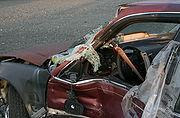
Car People Safety
The No. 1 thing to remember when it comes to children and cars? Teach children well. Teaching them not to play in or around cars, and to move away from a vehicle when a driver gets in and when the car is started can significantly mitigate all rollaway deaths, back over deaths and trunk entrapment. Although many cars come with detection devices like backup cameras or radars that emit sounds when they sense an obstruction behind the car, they cannot compensate for the act of circling the vehicle to make sure everything and every one is out of the way.
Installing Child Seats
Safety seats are another big component of safe driving with infants and toddlers. Parents should know that children progress from rear facing, to front facing, to booster seat to seat belts--in that order, and according to manufacturer directions for height and body weight.
Even very small infants must be in a child seat, not a sling, soft infant carrier or harness. ("Nothing is safer than a rear-facing seat," Baer says. If the baby's head slips forward, place a rolled towel under the front edge of the baby carrier and using rolled towels on each side of the baby's head for extra support.)
Beat the Heat
A final precaution: Never leave children or babies unattended in a closed vehicle, even for a minute. According to NHTSA, even cool outside temperatures in the 60s can cause the car's interior to hit 110 degrees Fahrenheit and higher. (The inside temperature can rise almost 20 degrees within the first 10 minutes.) What's more, children's bodies overheat easily--infants and children fewer than four are among those at greatest risk for heat-related illness--and children are less able to lower their body heat by sweating.
Five Ways To Keep Your Kids Safe In The Car
1. Babies face backward.
Face babies backward in their car seats. And keep them that way for as long as possible up to the height or weight limit of the particular seat. At a minimum, keep infants rear facing until the age of 1 and until they weigh at least 20 pounds.
2. Toddlers face forward.
Keep toddlers in forward-facing car seats until they reach the upper weight or height limit of the particular car seat (usually around age 4 and 40 pounds).
3. Use a booster seat.
Keep young children in booster seats--in the back seat--until they are as old as 8 years or at least 4'9'' tall. One way to tell if they're positioned correctly in the booster is to look at the seat belt: It should fit with the lap belt laying across the upper thighs and the shoulder belt fitting easily across the chest.
4. Protect your pregnancy.
When pregnant, wear the seat belt low across the belly, with the center portion placed firmly along the breastbone. Contrary to some myths, it's always safer to wear a seat-belt, even when eight or nine months pregnant, than to not wear one for fear of crushing the unborn child in the event of a crash.
5. Never leave children inside a parked car.
According to NHTSA, even cool outside temperatures in the 60s can cause the car's interior to hit 110 degrees Fahrenheit and higher. If a child is inside the vehicle, they can quickly succumb to heatstroke and death.
It's happening around the world -- kids dying from being left unattended in cars. The kids that don't die suffer thermal burns from seat belt buckles, severe dehydration, kidney damage, and brain damage.
- Unattended children may become entrapped in the trunk, set a vehicle in motion, or be abducted.
- Parking in the shade or leaving windows open doesn't protect kids. Even on cool days vehicles can heat up quickly, with the greatest increase occurring in the first 15-20 minutes.
- If the outside temperature is 75 degrees the temperature inside the vehicle can spike to 110 degrees in just 10 minutes.
- Metal vehicles, especially dark ones, act like solar ovens. When the outside temperature is 93 degrees the inside temperature can shoot up to 125 degrees in 20 minutes.
- Infants and toddlers are more sensitive to extreme heat. According to a 2002 Centers for Disease Control report, most fatalities occur in children three years old and under.
- Heat stroke (hyperthermia) occurs when the body temperature reaches 104 degrees. But in many cases of heat stroke the child's body temperature had reached a whopping 108 degrees, the highest number on a thermometer.
- An average of 29 children died per year in 1998-2002 from being left unattended in vehicles.




